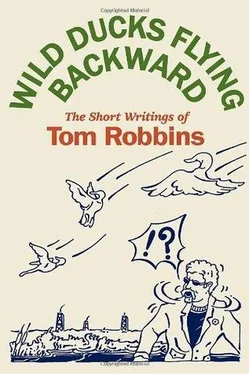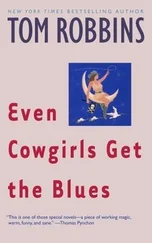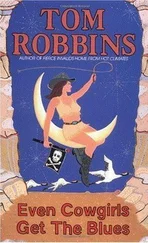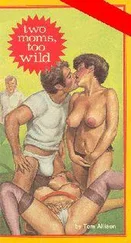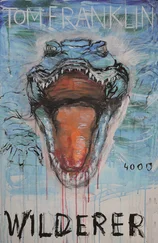We stumbled about pessimistically in that Thanksgivingscape for a while. And abruptly, there it was! There was no mistaking it. We couldn’t make out details, but the site was so charged it practically had an aura around it. The three of us glanced at one another knowingly, then, bucking the wind, took off at a fast trot. And we didn’t slow down until we were surrounded by a plenitude of pudenda.
I looked one of the specimens right in the eye. “Doctor Vagina, I presume?”

The official name of the place is innocuous: North Canyon. It’s quite narrow and fewer than two hundred yards long. The entire canyon is rather vaginal in shape, terminating in a scooped-out basin of white alkali that those so inclined could read as uterus or womb . The canyon floor is hirsute with juniper and sage.
According to Jon’s compass, North Canyon lies on a perfect east — west axis. The entrance is at the east end, where it’s most narrow. Obviously, there’s a strong solar connection. When the sun rises each morning, it passes through the natural gateway, moving up the passage to the “womb.” The volcanic-ash-flow walls are a yellowish orangish reddish tan, which is to say, the palette of the sun.
Both facing walls of the canyon entrance are covered with petroglyphs. No, somehow “covered” doesn’t do them justice. They are singing with petroglyphs.
A petroglyph is a drawing that has been pecked, incised, or scratched into stone. Frequently, as is the case at North Canyon, the rock exposed by the pecking is appreciably lighter in color than the outer surfaces, which have been patinated by millennia of oxidation. This affords the design excellent contrast, although as the centuries hop along, the uncovered rock, too, gradually darkens.
There are innumerable examples of petroglyphs in the western U.S., some of them ceremonial in intention, some mnemonic, some totemic (clan symbols), and some, it would appear, just an outburst of pleasurable doodling. The majority of the drawings are concerned with game, for the artists who chipped them were hunter-gatherers, and they may or may not include human figures. In addition, there are highly mannered petroglyphs and examples that are completely abstract.
The rock panels at the portal to North Canyon support a smattering of curvilinear abstractions, including the mysterious dot patterns that are characteristic of Great Basin rock art. There are a goodly number of enlarged bird tracks, apparently the symbol of the Bird Clan. And there is a rendering of a European-style house and a miner’s charcoal kiln, proving that Indians were still pecking at the site well into the nineteenth century. By far the dominant motif of North Canyon, however, is the stylized vagina.
The vagina glyph is not exactly rare on the rocks of the West, but at no other site is it found in such concentration or profusion. In an old shaman’s cave on nearby Hickison Summit, there’s a lone yoni of great loveliness, but North Canyon, oh mama! North Canyon is a festival of female genitalia, a labial showcase, a vulval jubilee, and clearly the wellspring of our indigenous tantra.
Rome wasn’t built in a day, to coin a phrase, and neither was this vaginal display. Worn, overlapped, and overlaid, the drawings were pecked over a long period of time. Human habitation in the region dates back ten thousand years. Volcanic ash is too soft to hold an image for such a lengthy period, but one of the few archeologists to give North Canyon more than a passing nod has estimated that it could maintain a vulva in fairly good condition for about five centuries. Shelley Winters, eat your heart out.
Although the Paiute may have had a finger in them, the best guess is that North Canyon’s murals are the work of the Shoshoni, a seminomadic civilization of underestimated complexity. The question is, Why? Why did they adorn the sun gate of Nevada’s high desert with scores of mannered pudenda? Perhaps North Canyon was a fertility motel that Shoshoni couples checked into in order to ensure conception. Perhaps it involved a type of coming-of-age ritual. Perhaps — and your pilgrim favors this theory — it was intended as an homage to that feminine principle that the Shoshoni recognized to be the genesis of continuous creation: Earth herself; mother of deer, mother of trout, mother of grass seeds, bulbs, and roots, mother of the ground on which they walked and the cliffs that sheltered them. Maybe, on the other hand, North Canyon was purely sexual, a horny pecking of individual lust into the enduring dimension of stone.
It’s reported that there are heterosexual males who can stare down a vulva, real or rendered, and register not an erg of prurience, but, honestly now, do you trust these guys? Would you want your daughter to marry one?
At any rate, many of North Canyon’s vaginas are bull’s-eyed with holes that have been “worried” by sticks. Assuming that the sticks were surrogate penises, there definitely was some sort of copulative magic going on. The energy of the place is openly erotic, and at the same time keenly spiritual. Presumably, the Shoshoni would have found no contradiction.
We stood there in a whirl of white flakes, eating a full ration of grit, letting the wind paint our ligaments blue, feeling somewhat sexy and somewhat religious, feeling a little like laughing and a little like weeping, until we got so cold we could no longer feel anything but the necessity of a steaming bath. Since the nearest public lodging was more than a hundred miles away, we set out for it at once, saving a closer examination of the curious canyon for a more hospitable day.

That evening, in the dining room of Tonopah’s Mizpah Hotel, the chicken-fried steak was delivered to Alexa, a vegetarian, while Jon, a raging carnivore, received the bowl of iceberg lettuce. The aging waitress grinned at the mistake, and tugged at the lapels of her dotted-swiss uniform. “Does the right table count for anything?” she asked. Apparently not, for the hot turkey sandwich that your pilgrim ordered (all that sagebrush had awakened a most nostalgic craving) landed on a table across the room, where it was instantly devoured by a man wearing a hat.
While our waitress labored to correct the mix-up, the lights went off. Then, on again. Off. On. Off. On. At least four times. “Happens all the time,” said the waitress. “Not to worry. It’s just the wind knocking two wires together.”
Jon found the explanation less than plausible, but as I suffered the long wait for a turkey sandwich to call my own, it occurred to me that here was a pretty good metaphor for west-central Nevada: two wires knocking together in the wind. In the high desert, the present knocks against the past, development knocks against nature, repression against indulgence, reality against dream, masculine against feminine, the Goddess of Destruction against the Goddess of Creation, the Atomic Proving Grounds against the Canyon of the Vaginas.
For two blustery days, we holed up in the hotel, chasing fruit around the cylinder of a slot machine and watching garbage-can lids UFO past the leaded windows. On the third day, the wind fell over dead and the temperature rose forty degrees. When we drove back to North Canyon, the sky was as blue as our waitress’s beehive, and a silky calm lay upon the land. Inside the canyon, the peace index tripled. It struck us as a haven, a refuge, a place where even the undeserving might be safe. Small and sweet, the canyon was nonetheless so powerful that its vectors held one’s soul upright, afloat, as if in metaphysical brine.
Читать дальше
